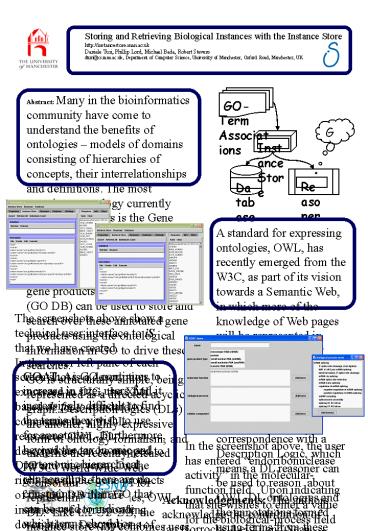Storing and Retrieving Biological Instances with the Instance Store - PowerPoint PPT Presentation
Title:
Storing and Retrieving Biological Instances with the Instance Store
Description:
Storing and Retrieving Biological Instances with the Instance Store ... or have transporter activity function and are not localized to a chloroplast. ... – PowerPoint PPT presentation
Number of Views:28
Avg rating:3.0/5.0
Title: Storing and Retrieving Biological Instances with the Instance Store
1
Storing and Retrieving Biological Instances with
the Instance Store http//instancestore.man.ac.uk
Daniele Turi, Phillip Lord, Michael Bada, Robert
Stevens dturi_at_cs.man.ac.uk, Department of
Computer Science, University of Manchester,
Oxford Road, Manchester, UK
Abstract Many in the bioinformatics community
have come to understand the benefits of
ontologies models of domains consisting of
hierarchies of concepts, their interrelationships
and definitions. The most prominent ontology
currently used by biologists is the Gene Ontology
(GO), which currently consists of over 17,000
terms. In addition, GO has been used to annotate
several million different gene products. The GO
database (GO DB) can be used to store and search
over these annotated gene products using the
ontological information in GO to drive these
searches. GO is structurally simple, being
represented as a directed acyclic graph.
Description logics (DLs) are another, highly
expressive, form of ontology formalism, and
underlie the recently released W3C (World Wide
Web Consortium) standard for representing
ontologies, OWL-DL. Like the GO DB, the instance
store (iS) combines uses a commodity relational
database but combines it with a DL reasoner,
which enables it to search and retrieve using the
rich expressiveness of a DL. While the GO DB
performs well with a structural simple ontology
such as GO, we believe iS may offer a possible
implementation path for searching over richer and
more expressive ontological information as it
appears.
GO-Term Associations
GO
Instance Store
Reasoner
Database
The screenshots above show a technical user
interface to iS that we have created. In the
lower left pane of each screen shot is a
description expressed in DIG, the XML-based de
facto standard to communicate with DL reasoners.
OWL-DL descriptions can be mapped to DIG and vice
versa. On the right are all the gene products of
the GO DB that are instances of corresponding
description. Descriptions of arbitrary
complexity can be used, fully utilizing the
expressivity of OWL-DL.
GOAT As GO continues to increase in size, users
find it increasingly difficult to find the terms
they wish to use for annotation. Furthermore,
beyond the taxonomic and partonomic hierarchical
relationships, there are no constraints within GO
that can be used to indicate which terms should
or should not be used together in the annotation
of a given gene product, potentially resulting in
inconsistent or even nonsensical descriptions of
gene products. Relying upon a description-logic-b
ased version of GO, mined GO-term-to-GO-term and
GO-term-to-gene-product-type associations, and
the FaCTreasoner, GOAT aims to guide the user in
the annotation of gene products with GO terms by
displaying those field values that are
appropriate based on previously entered
terms. GO-term-to-GO-term associations were mined
from the complete version of the Gene Ontology
Annotation (GOA) database. We compiled
associations of GO terms in the sense that the
two terms that make up each associative pair
(i.e., a given GO term and (one of) its
associated GO term(s)) have been used together as
annotating terms in at least one database entry
of GOA. The iS system is used to hold these
associations While each concept of our
description-logic-based GO represents a GO term,
each instance in iS is an association record for
a corresponding GO-term concept in the ontology.
Each association record refers to its
corresponding GO term and to the set of other GO
terms with which that term is associated.
In the screenshot above, the user has entered
endoribonuclease activity in the
molecular-function field. Upon indicating that
she wishes to enter a value for the
biological-process field (by pressing the Add
term button next to the biological-process text
area), GOAT dynamically attempts to retrieve the
association record for endoribonuclease
activity from iS. Thus, rather than displaying
all terms of the GO biological-process
subontology, GOAT only presents the much smaller
subset of biological-process terms most likely to
be appropriate based on the represented
associations to the annotation the user has
already entered for this gene product.
Acknowledgements The authors acknowledge the
contribution of Ian Horrocks, Lei Li and Sean
Bechhofer to the design and implementation of iS.
DT was supported by the MONET EU project
IST-2001-34145. PL was supported by myGrid UK
e-Science programme EPSRC GR/R67743. MB
was supported by e-Science North-West Centre.































